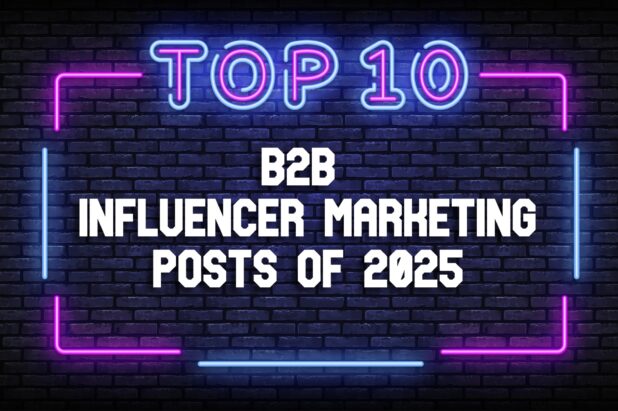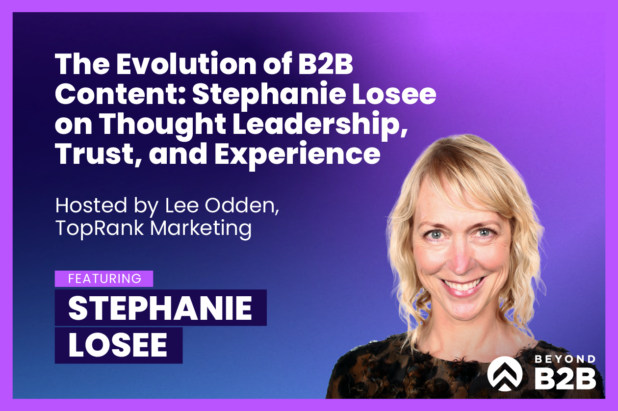Many marketers think about influence from a B2C perspective: a lifestyle creator unboxing a product, a viral post driving clicks, a familiar face tied to a limited-time offer. It’s fast, transactional and built to spark quick purchase decisions.
But for those of us working in the B2B world, the short term transactional approach rarely fits the reality on the ground. Sales cycles stretch over months. Buying decisions involve multiple stakeholders with competing priorities. And trust, rather than popularity, is the currency that drives results.
Sophisticated marketers know there is no “one size fits all” approach to influencer marketing. So if you’ve ever tried to apply a typical B2C-style influencer campaign to B2B, you know how frustrating it can feel when short-term tactics don’t translate to long-term results. That’s because B2B influencer marketing isn’t built on quick wins. It thrives when treated strategically, as an always-on discipline.
See B2B Influencer Marketing in Action
The limitations of a tactical B2B influencer approach
For many B2B companies, tactical influencer marketing often takes the shape of a single campaign or quick engagement. A brand might bring in one industry voice to promote a new white paper, sponsor a LinkedIn post around an event, or collaborate on a single piece of content without any follow-through. These efforts tend to be short-term and disconnected from the broader brand narrative.
On the surface, a tactical approach can feel appealing, especially if you’re under pressure to launch something fast, hit short-term KPIs, or show quick activity. In the moment, they often do generate a bump: impressions rise, clicks spike and a reportable metric is checked off.
But here’s the catch: those results rarely last.
Without consistency, the credibility of the influencer doesn’t carry over into the next quarter. Without deeper integration, the campaign never fully connects to your buyers’ journey. The outcome is often a one-and-done piece of content that lives in isolation, instead of fueling trust and momentum.
It’s not that tactical influencer efforts have no value — they can serve a purpose when used intentionally. The problem comes when they’re mistaken for a complete influencer strategy. If credibility, trust and long-term growth are your goals, tactical wins alone won’t get you there.
Why strategic influencer marketing wins for B2B brands
In 2025, the average B2B customer journey is 211 days, and even longer at large companies. (Dreamdata)
Sales cycles for B2B companies aren’t built for speed. They unfold over months (sometimes years) and involve committees of stakeholders who each bring different perspectives, priorities, and pressures to the table. In this environment, a stand-alone collaboration isn’t enough to influence real decision-making. What buyers are looking for is steady credibility — expertise that shows up consistently, over time, in the places where they’re already seeking insight.
That’s why strategic influencer marketing is such a power play. Unlike tactical and transactional efforts, strategic programs are always-on, relationship-driven, and fully integrated with a brand’s broader content and storytelling. A strategic approach to influence is central to building a trust engine for your B2B brand.
The payoff is hard to ignore. TopRank’s own research shows that 58% of B2B marketing teams use an always-on approach, with the numbers climbing higher among leaders: 82% of the most successful teams and 81% of the most mature teams have embraced it. Even more compelling, 99% of marketers using always-on strategies rate them effective. And according to McKinsey data, long-term influencer partnerships deliver 35% higher engagement rates compared to single campaigns.
What these numbers reveal is something many marketers have already felt: strategic, consistent collaboration is the key to building authentic authority in an environment where buyers are skeptical, overwhelmed and starved for trustworthy insight.
Building an always-on B2B influencer program
So what does a truly strategic approach look like in practice? It begins with treating influencer relationships as partnerships. The goal isn’t to secure a quick endorsement but to foster collaboration that creates value for both your audience and your brand.
Three attributes stand out:
Relationship-first
Brands invest in building trust and rapport with influencers over time. This means listening, collaborating and aligning on shared goals — not just striking a single deal.
Integrated across channels
Influencers are woven into the full spectrum of brand activity, from content hubs and webinars to social campaigns, live events and beyond.
Collaboration on thought leadership
The strongest results come when influencers co-create meaningful insights (a research report, podcast episode or video series) instead of simply promoting something.
And tactically, that might look like:
- Building a community of go-to experts who help shape content and keep your brand tapped into the conversations that matter.
- Establishing co-creation rhythms — regular blogs, podcasts or serial videos that highlight influencer expertise alongside your own.
- Maintaining steady engagement by spotlighting influencer voices across multiple touchpoints.
When approached this way, influencers evolve from marketing mercenaries into genuine collaborators who strengthen credibility and expand reach. Each engagement adds to the foundation of trust you’re building, making your overall program more resilient and effective over time.
The payoff of playing the long game
Here’s the part that can be hard to hear when the pressure for pipeline is high: B2B influencer marketing is not designed to deliver instant leads. If you measure it by the same short-term standards as a paid click campaign, you’ll almost always be disappointed.
The true value lies in what builds over time. With every webinar, co-authored article, or podcast appearance, influencers deepen their connection to your brand and extend your credibility to new audiences. Buyers begin to recognize those expert voices as steady companions in their decision-making process.
The payoff of playing the long game is durable influence — the kind that not only elevates content performance but also shapes how buyers perceive and trust your brand across an extended journey.
Ready to see what a long-game strategy looks like in action?



